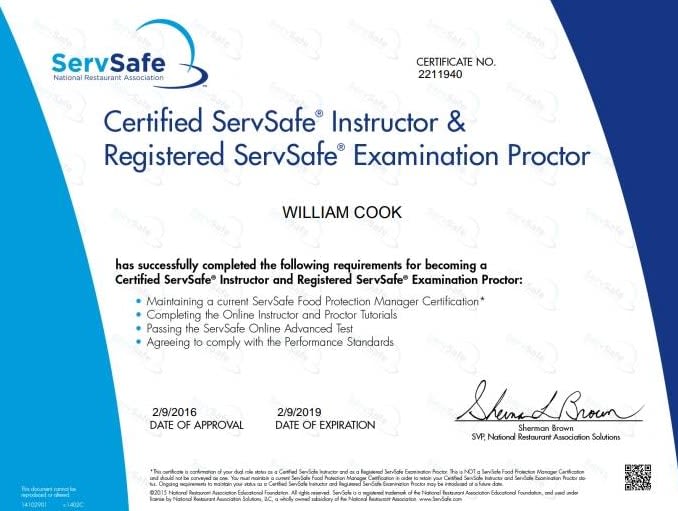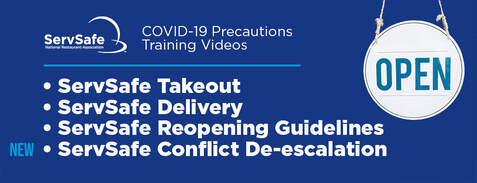Quick Tips for Effectively Finishing Your ServSafe Food Handler Training Course Online
Quick Tips for Effectively Finishing Your ServSafe Food Handler Training Course Online
Blog Article
Comprehensive Food Handlers Educating for Health and Safety And Security
In today's rapidly evolving food service landscape, extensive food handlers training has arised as a vital element for guaranteeing hygiene and safety. By instilling vital methods associated with hand health, food storage space, and hygiene, this training not just alleviates the danger of foodborne diseases but likewise strengthens compliance with regulatory standards. The implications of such training expand past simple compliance; they touch upon public health and consumer trust fund. Yet, the performance of these training programs can differ substantially. What aspects genuinely determine their success in cultivating a society of safety?
Significance of Food Safety And Security Training

Additionally, food security training aids to guarantee that staff members understand present laws and guidelines, which are crucial for maintaining operational licenses and preventing pricey fines. Normal training sessions also act as a platform for strengthening finest techniques, thus reducing the chance of human error, which typically offers as a leading reason of food contamination.
Additionally, investing in food safety training can improve a facility's track record, as customers increasingly prioritize dining experiences that mirror high safety and security standards. Such proactive measures not only shield customers yet additionally contribute to the long-term success of food organizations. In summary, comprehensive food safety training is a vital component of food solution procedures, directly affecting both public health and wellness and service sustainability.
Secret Principles of Hygiene
Maintaining high criteria of health is necessary in any type of food managing atmosphere to avoid contamination and guarantee the safety of consumers. The vital concepts of hygiene include a number of vital practices that food trainers have to constantly apply.
First, hand health is vital; food handlers need to clean their hands completely with soap and water before and after taking care of food, in addition to after utilizing the washroom or touching any kind of possibly infected surface areas. Devices and surfaces should be routinely cleaned up and sterilized to eliminate virus. This includes tools, cutting boards, and counter tops, which ought to be kept in a clean problem.


Correct food storage is additionally important; raw foods should be kept separately from prepared or ready-to-eat items to prevent cross-contamination. servsafe certifications. In addition, preserving ideal temperature controls is critical; disposable things ought to be maintained secure temperatures to hinder bacterial growth
Last but not least, personal hygiene can not be forgotten. Food handlers ought to put on clean garments, usage hair restraints, and prevent functioning when ill. By adhering to these crucial principles of health, food handlers can substantially lower the risk of foodborne health problems and advertise a safer dining experience for all customers.
Typical Foodborne Illnesses
Although numerous foodborne health problems can be protected against through appropriate health and risk-free food taking care of practices, they stay a substantial public wellness concern. Foodborne pathogens can cause a range of ailments, varying from light stomach distress to severe problems and even death.
Typical foodborne health problems consist of salmonellosis, brought on by Salmonella microorganisms, usually connected to undercooked poultry and eggs. Another prevalent illness is listeriosis, related to unpasteurized dairy items and ready-to-eat meats, which can be specifically hazardous for immunocompromised people and expecting ladies. Norovirus, often acquired from contaminated food or surfaces, is recognized for its fast spread and capability to trigger break outs in common settings.
Escherichia coli (E. coli) infection, notably related to undercooked hamburger and polluted produce, can result in severe abdominal aches and kidney failure sometimes. Additionally, Clostridium perfringens, typically discovered in large amounts of food that are poorly kept, can cause food poisoning with signs and symptoms showing up shortly after consumption.
Understanding these ailments is vital for food handlers, as awareness can dramatically minimize the danger of contamination and protect public wellness. Correct education and training are essential elements in combating foodborne conditions.
Finest Practices for Food Handling
Efficient food handling techniques are crucial in stopping the spread of foodborne illnesses. To start with, appropriate hand health is necessary; food handlers have to wash their hands thoroughly with soap and water prior to and after dealing with food, specifically raw meat or poultry - servsafe food handler. This simple activity significantly decreases the threat of cross-contamination
Second of all, maintaining proper food storage temperatures is critical. Perishable products need to be stored at or below 40 ° F(4 ° C) to prevent microbial growth. Furthermore, prepared foods need to be kept above 140 ° F(60 ° C) up until offered.
Finally, ensuring tidiness of surface areas and tools is crucial. Consistently sanitize countertops, cutting boards, and utensils, especially after preparing raw foods. Usage different cutting boards for ready-to-eat and raw foods to further minimize contamination risks.
In addition, when preparing food, it is essential to adhere to the concept of "initial in, initially out" (FIFO) to handle stock efficiently and decrease putridity. Finally, always stick and check out to food labels for safe cooking temperatures and taking care of guidelines. By applying these finest practices, food handlers can considerably enhance food safety and security and shield public health and wellness.
Implementing a Safety And Security Culture
Developing a safety and security society within a food dealing with setting is necessary for fostering a dedication to food security among all team member. This culture stresses the value of food safety and security as a shared responsibility, motivating employees to focus on hygiene techniques consistently.
To carry out a safety culture, companies ought to start by offering comprehensive training that attends to food handling protocols, possible hazards, and the value of individual health. Training sessions must be interactive and tailored to the certain duties of employee, guaranteeing importance and engagement.
Moreover, leadership plays a crucial function in developing this culture. Administration needs to model risk-free techniques and communicate the value of food safety and security on a regular basis. Identifying and rewarding workers that promote safety requirements can additionally reinforce these habits.
In addition, open communication channels need to be developed, permitting team to report safety concerns without fear of consequence. Routine security audits and responses sessions can aid identify areas for renovation and reinforce accountability.
Eventually, growing a security society not just improves compliance with food security guidelines however likewise safeguards public health, fosters employee spirits, and adds to the total success of the food taking care of facility.
Verdict
To conclude, thorough food handlers training plays a crucial role in advertising health and security within food service establishments. By equipping employees with essential knowledge about food safety concepts, typical foodborne health problems, and finest practices for handling food, such training significantly lowers health and wellness risks. Fostering a society of safety boosts the facility's credibility and straightens with consumer assumptions for high security criteria, eventually adding to public health and wellness defense and the general success of the food solution market.
In today's swiftly developing food solution landscape, extensive food trainers training has emerged as a critical element for guaranteeing health and safety.Food security training is crucial for preserving high criteria in food handling and preparation, with research studies showing that proper training can minimize foodborne ailments servsafe food handler by up to 30%. In summary, thorough food safety and security training is a vital element of food service procedures, straight influencing both public health and service sustainability.

Report this page